INTERVIEW 2018
by Marina Antunes, Spark CG Society
December 14, 2018
Breaking the Rules Pays Off in Spider-Man: Into the Spider-Verse
The late Stan Lee often said Spider-Man was his favourite superhero, and the character has also been a long-time fan favourite, making his small-screen debut a mere 15 years after first appearing in a comic book.
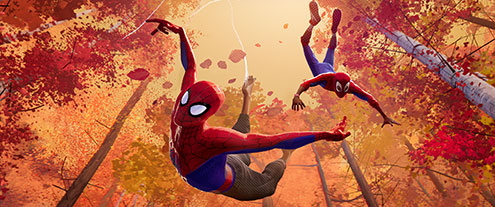
In the intervening years, the character has seen a number of iterations, but the introduction of Miles Morales as Spider-Man in 2011 opened the door not only for a new take on the character in the comic books, but also for the character on the big screen.
Enter Phil Lord and Christopher Miller, the creative minds behind The Lego Movie and 21 Jump Street, who saw the opportunity to bring a new Spider-Man to the masses. But this new Spider-Man had to be different and that was the challenge put forth to the crew behind Spider-Man: Into the Spider-Verse including VFX Supervisor Danny Dimian of Sony Pictures Imageworks.
“As a visual effects supervisor, I’m sort of the coach of all the artists and engineers,” Dimian explained over the phone from SPI’s Vancouver office. The challenge with Spider-Verse was that neither the coach nor team knew what the game they were playing looked like.
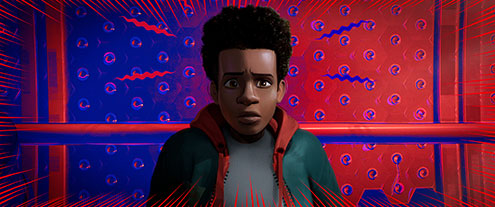
The Challenge
“The only thing we knew at the beginning of the project was what we didn’t want it to look like. We didn’t want it to look like something we’d seen before,” and finding that new look was a challenge Dimian and his team were ready to tackle. “Doing individual effects that nobody has seen before is not that scary but we wanted to find a new visual language and that was kind of scary for me: keeping it emotional and still being new.”
So where to start? “We started with amazing artwork from production designer Justin Thompson and the visual development team. These amazing original designs were inspired by comic book artists and illustrators but they also looked to push the film to a new and fresh look.”
The next step was to throw away the rules. “We didn’t want to be held back by anything that we already did or already had. We really wanted the pipeline to be led by, visually, what we wanted it to do and what the movie would look like.”
Getting the new look of Spider-Verse took approaching the project differently and that began with Dimian speaking to artists from the moment they signed onto the project and encouraging experimentation. “When artists came on to the show, I would talk to everyone about how this was going to be a different experience. We asked everyone to try to do something different and do it just out of exploration so that we could see if there were any mistakes that would result in something cool. Every artist in every department brought something to the project.”
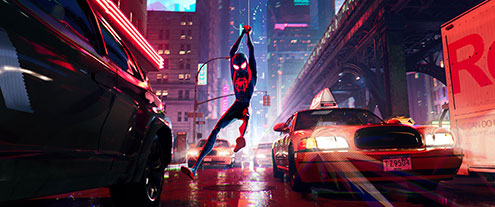
The team started with three test shots: the iconic Spider-Man swinging through the streets, another featured the geometry of the city and the third was a close-up of Gwen. Dimian wanted to ensure that they could capture both the big blockbuster aspects of the storytelling as well as the emotional moments. “It was challenging to find that sweet spot between being completely different but not crossing that line into where the technique is too far out that it takes you out of the movie because at the end of the day, you still have to serve the story and the emotion. We learned a lot from these early shots and continued to work with the visual development team to refine the designs.”
Looking different while still telling an emotional story was a balancing act. “At the beginning, it’s scary because you have one thing you like because it checks some of the boxes — it looks different, it looks hand-done it looks like it could fit in a comic book world — but the more things you piece together, a 2D inspired or drawn explosion here, line drawn on the face there... as the pieces started to fall into place and we did some test shots to see what worked and what didn’t, then you start feeling what is right about the world.”
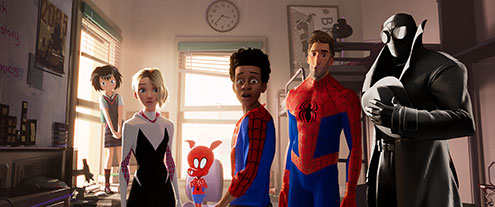
Working without a roadmap made for a lot of challenges but one thing that Dimian keeps coming back to is ensuring that whatever he and his team were experimenting with didn’t detract from Spider-Verse’s emotional resonance. “The challenge of the characters was to make them very expressive and emotional and at the same time have them be stylized and simplified. That’s why we spent so much effort coming up with drawing lines on the characters’ faces, hands, everywhere. That was a challenge for animation: how to make faces very expressive.”
On the effects side, the challenge was a little different. “The effects are heavily simulation-based and we discovered that if we relied too much on the simulation and didn’t find way to break it in ways that felt more artistically driven or design driven, it didn’t feel right. It gave us too much realism and took it out of our world.”
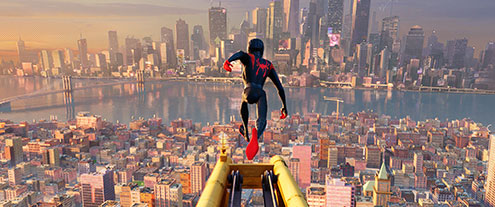
It’S All About the Lines
Dimian realized early on that the line work would be an integral part of the project and that drawing those lines would require new tools. The effects team helped to automate the drawing of non-expressive, predictable lines on things like hands and ears, with machine learning which helped reduce iteration and saved time but expressive lines were more complicated. “We developed software that was written specifically to allow an artist to draw all of the lines like an illustrator.”
The software allowed the artist to draw lines on a three dimensional model on-screen just as one would as an illustrator not confined or constrained by what’s underneath. Those lines were then mapped onto the geometry to be rigged so that it behaved properly in 3D.
The lines also led to a happy accident which turned into a full ‘look.’ “In a couple of renders, the geometry was actually turned off so what we got was a render with just the line work left behind. That happened to be at the same time when we were trying to figure out the invisibility look for Miles. A part of the invisibility look was inspired by that method of having the character with just lines.”
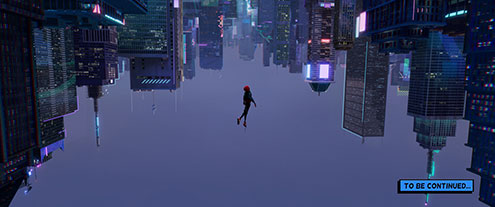
Rules
Though the key to making Spider-Verse feel new and unique was throwing out the rule-book, there were a few rules the team had to abide by in order to ensure that the universe felt like an actual, consistent world. One such rule was using line hatching in shadows and on architectural geometry while using half-toning in the lighter areas and atmospherics and on things that are organic like a face. “If we broke those rules or were inconsistent of them, it didn’t feel right.”
The few rules in place while making Spider-Verse were in service of telling the story but the general theme of production was to break rules rather than make them. “We joked that we were going to change the expression ‘if it ain’t broke don’t fix it’ to ‘if it ain’t broke, break it.’ We really wanted the artists to have a feeling of experimentation and the freedom to actually try new things because we knew that was the only way to find something new.”
Mission accomplished.
Sony Pictures Animation © 2018 CTMG. All Rights Reserved.
 |
Marina Antunes is a Vancouver-based writer who has been dishing on film for various websites since 2005. She is the Editor-in-Chief of Quietearth.us and co-hosts a film podcast called After the Credits. Marina is a member of the Online Film Critics Society and the Alliance of Women Film Journalists. She joined the Spark CG Society as Festival Director in 2013. |
![]()
![]()
© 2024 · Spark CG Society














